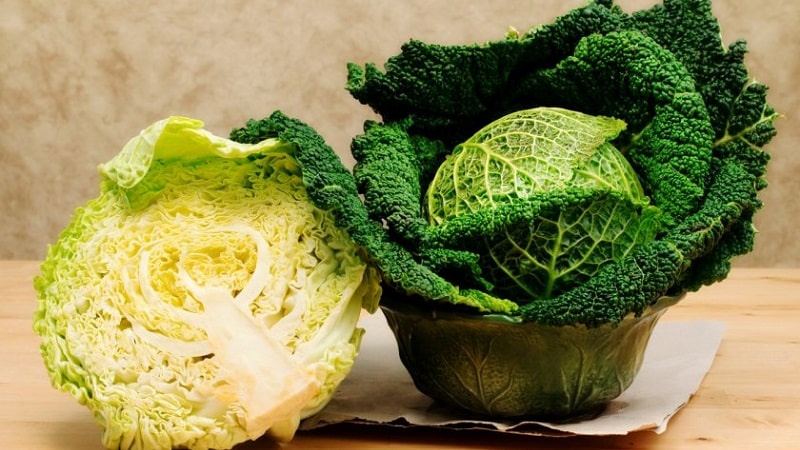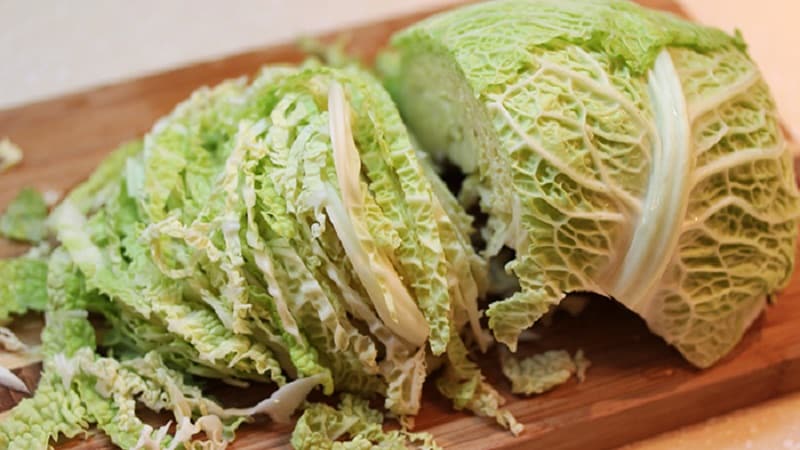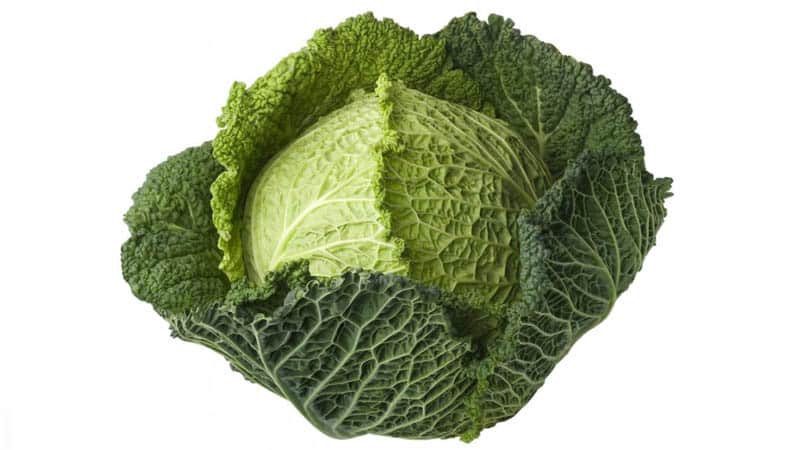Proven ways to store savoy cabbage for the winter at home
Savoy cabbage is a low-calorie vegetable rich in vitamins and minerals. In composition and taste it is not inferior to others. Let's consider how to choose and lay these correctly vegetables for the winter, and how to preserve their properties as much as possible in order to saturate the body with useful substances all winter.
Features of storing savoy cabbage
If cabbage is planted from the garden, the harvest is harvested at a temperature not lower than -6°C. Vegetables should not be watered before harvesting: they should be dry.
Basic recommendations:
- If planned keep vegetables with roots, they are carefully dug up. If without, the stem is cut with a sharp knife, the stalk is shortened to 3 cm.
- Harvest in dry weather.
- It is advisable to leave 2-3 tightly adjacent leaves on the heads of cabbage. They will protect against damage and prevent dirt from entering.
- It is better to keep Savoy cabbage in wooden boxes. The heads of cabbage are stacked at a short distance from each other with the stalk down.
To store for the winter, take vegetables weighing more than 500 g: the larger the fruit, the longer it will be stored.

Selecting and preparing cabbage
The heads of cabbage are dense and heavy with elastic leaves of a rich green color without spots or damage. Cabbage damaged by pests or rotten cannot be stored. To dry, the crop is sprinkled with crushed chalk and left for 2-3 days in a dry room.
Important! Cabbage will have a longer shelf life if you do not cut off its roots.
Suitable varieties
Early varieties and hybrids ripen 100–120 days after planting, medium ones – 120–135 days, late ones – 140 or more.
Late-ripening varieties are suitable for long-term storage: Alaska F1, Uralochka, Stilon F1, Ovasa F1, Lacemaker. They have a long growing season; the heads of cabbage ripen in the second half of autumn.
Storage methods

The most common options for storing Savoy cabbage for the winter are:
- in a basement or cellar (open or closed);
- on a balcony or loggia;
- in the refrigerator or freezer;
- under the snow.
In the cellar
The optimal place to store vegetables is a basement, cellar or garage. The room is prepared in advance:
- if there is mold on the walls, it is removed with antifungal agents;
- the room is thoroughly ventilated and dried;
- 3-4 weeks before planting vegetables, disinfect the walls, ceiling and floor with a solution of copper sulfate (100 g of product per 10 liters of warm water), a bactericidal primer or any antiseptic drug, then ventilate well;
- if rodents are present, get rid of them.
Basic conditions for storing vegetables indoors:
- air humidity - 85–90%;
- temperature - 0...+4°С;
- good ventilation;
- lack of light.
Their shelf life depends on the quality of preparation of the premises.
On the balcony
For long-term storage of heads of cabbage, only a glazed balcony or loggia is suitable. The temperature here should not fall below -6°C.
Advice. During severe frosts, cabbage is moved to a warmer place.
The heads of cabbage are first cleaned of dirty leaves and dried. If the air on the balcony is dry, vegetables are wrapped in paper. Place them in wooden or plastic lattice boxes.
In a refrigerator

How to preserve vegetables at home? This option is suitable for a small amount of harvest. The heads of cabbage are placed in vegetable boxes or placed in bags with holes made in them. The temperature in the refrigerator should be no more than +4°C.
The vegetables are taken clean and dry, the stalk is cut so that it protrudes 1-2 cm from the lower leaves.
In the freezer
It is inconvenient to keep whole cabbage in the freezer, so they make preparations from it.
For example, for cabbage rolls, cabbage heads are separated into individual leaves, blanched for about five minutes in hot water and left to drain on a towel. After drying, they are packaged in bags and sent to the freezer. Before use, the product is defrosted at room temperature.
Cabbage is also stored in chopped form: it is finely chopped and sorted into bags, added to soups and vegetable stews. Before cooking, the workpiece is not defrosted, but immediately sent to the pan. This will not affect the taste of the dish in any way.
Under the snow
Savoy cabbage is a frost-resistant vegetable. Possibility of storage under snow depends on weather conditions and is suitable for regions with early winter.
Attention! Vegetables are kept under snow until the temperature drops to -4°C.
If there is light frost and snow at the end of October, the cabbage is left in the garden. The beds are additionally sprinkled with snow so that the vegetables are completely covered with it. For consumption, cabbage is dug up, shaken off snow and left to thaw in a warm room.
Open storage

Shelves on racks for cabbage are made of wooden slats with gaps of 4-5 cm. Air circulation depends on this. Place the heads of cabbage separately from each other with the stalks facing up.
The harvest is also stored hanging: for this, vegetables are suspended from the ceiling or beam. If the root is not cut, it is pierced with wire or wrapped with rope. Cabbage without roots is sorted into separate mesh bags and hung.
In closed
This method is used at low humidity in the room. The harvest is kept in well-ventilated wooden or plastic boxes and covered with sand. They do it like this:
- The bottom of the box is covered with dry, clean sand (about 1-2 cm).
- Lay the heads of cabbage stalks up at a distance from each other and cover with a thin layer of sand (2-3 cm).
- The boxes are placed on pallets to allow air to penetrate from below.
The heads of cabbage are laid in several rows, making sure that they do not touch each other. Instead of sand, use a thick layer of paper, wrapping each fruit well.
Important! The drier the air, the shorter the shelf life of cabbage.
Pyramid shaped
If there is a lot of harvest, but there are no suitable containers or shelves, the vegetables are laid out in a pyramid on the floor in the cellar. The largest heads of cabbage are placed first, then the smaller ones.
Large fruits last longer, so they are removed further away, while small ones are placed closer and eaten first. Each layer is sprinkled with sand.
Attention! Cabbage is periodically checked for spoiled specimens.
Packaged
This method is most often used in apartments. Each fork is placed in a plastic bag with holes. Without them, the leaves will rot faster due to accumulating condensation. After packaging, the vegetables are sent to the refrigerator or taken out to the balcony.
Sometimes the heads of cabbage are wrapped in cling film, placed in bags or boxes and left on the balcony, shelves in the cellar and in the refrigerator. Such vegetables are stored for 20–30 days at low temperatures.
This is interesting:
What is fermented cabbage, what is it good for and how is it prepared.
Characteristics and description of the Zimovka cabbage variety.
Shelf life

The shelf life of savoy cabbage depends on the method chosen:
- vegetables can be stored for up to 12 months if opened;
- indoors - 6-7 months;
- in the refrigerator or on the balcony - 3-4 months.
Conclusion
Although Savoy cabbage is not as popular as white cabbage, it is superior in juiciness and amount of vitamins.
Many doubt the possibility of its long-term storage due to the delicate and soft structure of the leaves. However, vegetables do not lose quality and taste all winter long if they were properly selected and prepared and left at the appropriate temperature and humidity.